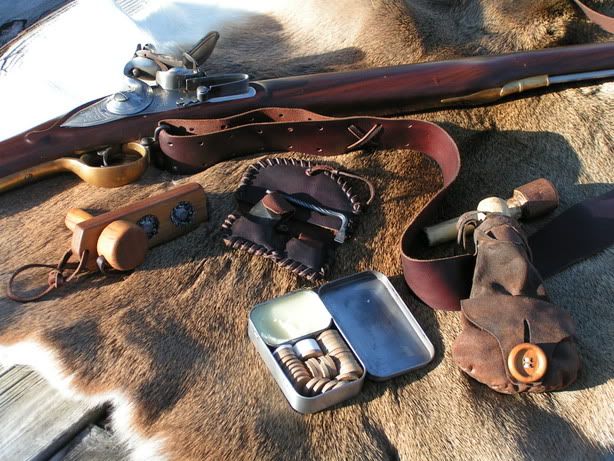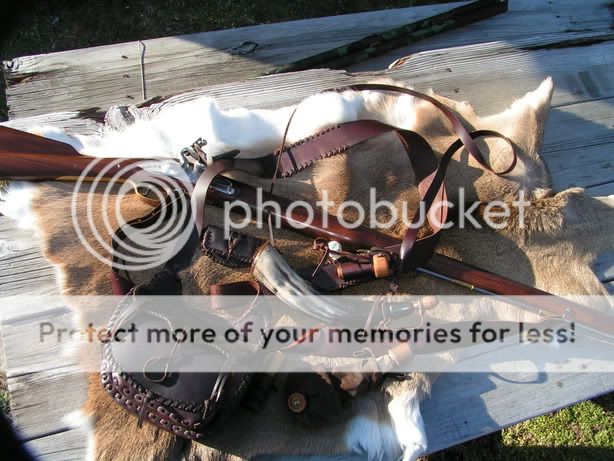Capt. Jas.
58 Cal.
- Joined
- Aug 19, 2005
- Messages
- 3,049
- Reaction score
- 1,352
a

Mike Brooks said:I would be concerned about the lube contaminating the powder in a hunting situation. Also I don't feel there is enough there to seal the bore properly. I have always found a hard card necessary for a good seal in combination with a fiber wad to carry some lube.Capt. Jas. said:Any of you guys tried splitting a lubed fiber wad in half adn using half for over powder and half for over shot with nothing else?


If I were loading that particular gun I'd load my standard load structure. Powder, 1/8"hard card, 1/2 lubed fiber wad, shot, and Os card.If using a stiff hunting lube just like that on a rifle patch which makes full contact with the top of the powder charge, would it not not be an issue?
The seal issue was my biggest question. I have tried this procedure out of necessity due to lack of components and found the patterns to be quite good at 20 and 30 yards with the .015 jug choke in Jake's barrel.
Although the paper looked good, I still question the penetration. It for sure seems to be better than tow wads when doing the 18th century bit and appears to work quite well for fast loading and close shots.
When I tried this, I used a dry half near the powder and a lubed half on the shot. The barrel after clean-up of roughly 30 quick shots was a breeze to clean except where the unlubed fiber had been at the powder.
Of course all bores are not going to be exactly the same even thought they may be labled as a 12, 16, etc.... and the tighter the bore, it would appear the better the factory cut fiber wads should perform.
Yep, still carry 3 different wads in the field, but I don't have to lube the bore after I load like you're having to do, which means I don't have to carry a separate lube container to wipe the bore with...I guess it is what ever works for you. One fellows way may not be better than an others. The exchange of information here is interesting.paulvallandigham said:Mr. Brooks. You are still carrying three different wads into the field with you. Carying only one seems to me to be a lot more simple. I do like your idea of wrapping the lubed wads in newspaper. It would not work with my moosemilk lube, but a different lube might do the trick. Can I ask again, what kind of lube are you putting on those cushion wads? I have the Circle Fly cushion wads made from Celotex, the building insulation material. The wads are about 1/2" thick. They can soak up a lot of liquid if you don't be very careful. A dab of bore butter, or even crisco might be a better way to go, NO?
Paul, again, I'm using solid Crisco that I melt on the stove in my sweetie's frying pan. I do a very quick dunk in the melted crisco and set them on a stack of paper towels to dry. The Idea here is to not let them soak up lube with out soaking up too much. You really only want lube on the outside so they stay light. As I said earlier, I have recently ordered some pre lubed fiber wads from Circle Fly that has a thicker lube than melted Crisco. These have proved to be absolutely ideal. The lube is thicker, I suspect some kind of wax/veggie oil combination. I'll probably not be going back to crisco once I've used up my current supply of fiber wads as I'll be buying pre lubed Circle fly from now on.Can I ask again, what kind of lube are you putting on those cushion wads?
Yes, those are exactly the wads I'm referring to, I've been using them since 1980. Yes, they can soak up way too much lube if you let them, that's why I will put emphasis on a QUICK dunk in melted Crisco. Also, If somebody has a cranky fowler that won't shoot fiber wads with out blowing a hole in the pattern, try 3/8 wool felt wads instead, that will usually solve the problem. I think Circle Fly sells them lubed or unlubed.I have the Circle Fly cushion wads made from Celotex, the building insulation material. The wads are about 1/2" thick. They can soak up a lot of liquid if you don't be very careful.
Yep, I agree, pretty clever! :hatsoff:I like the idea Mr. Archer uses of making the cushion and the overpowder one unit.
II made one of these out of a leather punch for punching cards with. I don't use wads just the cards, I choose not to poke holes in them too as if the ram is the correct diameter the wind will "fart" past them anyway :hatsoff:

Britsmoothy.
Enter your email address to join: